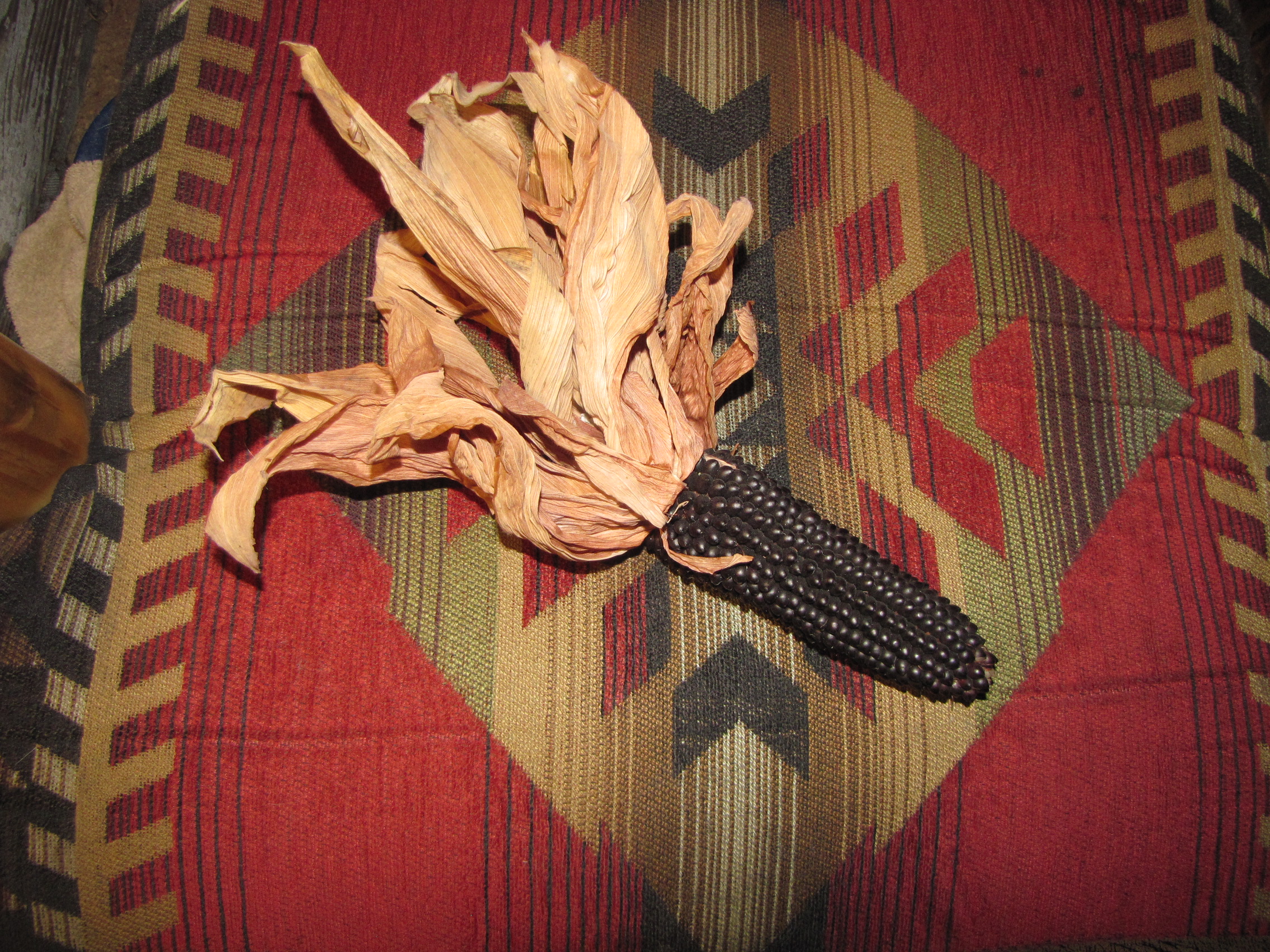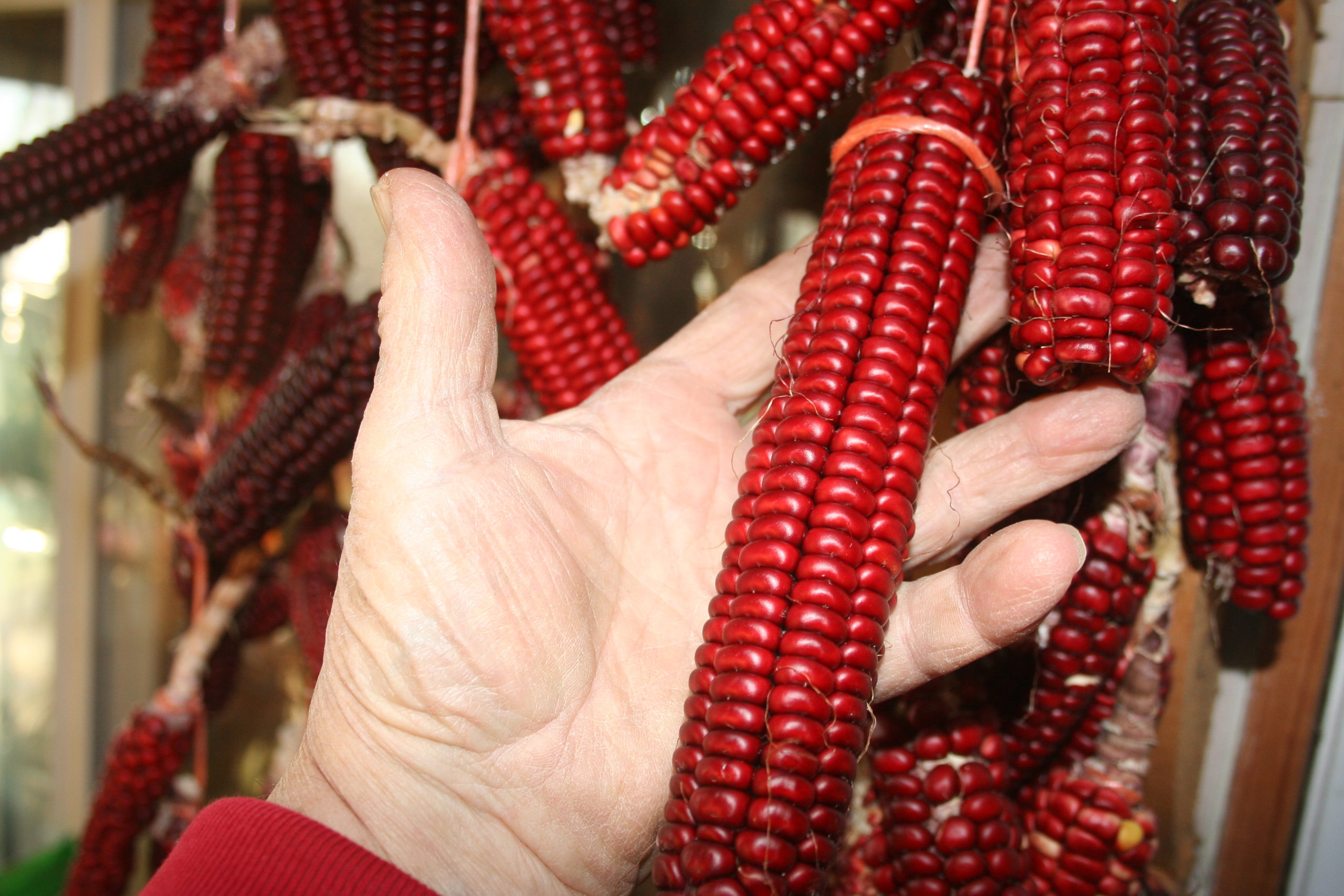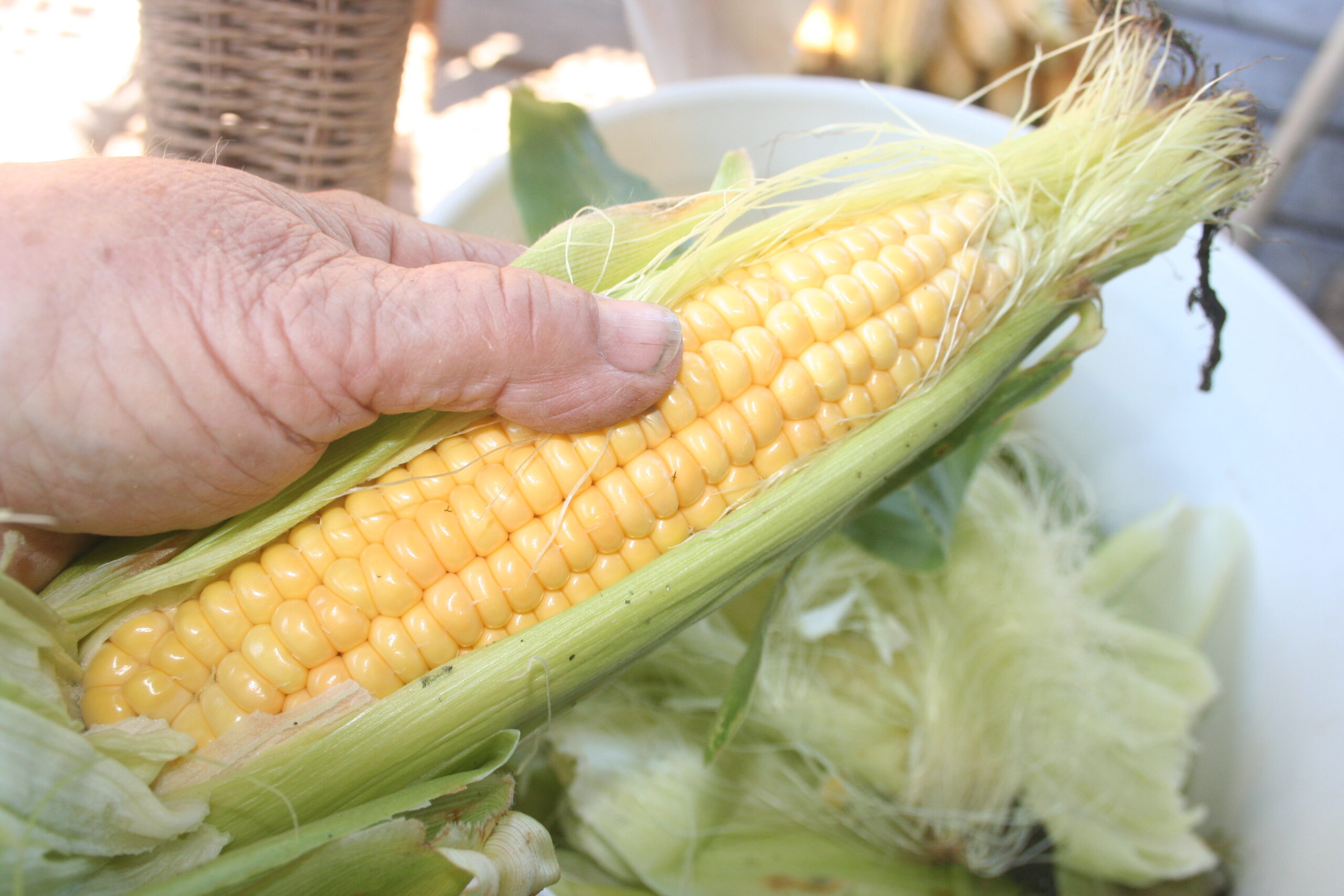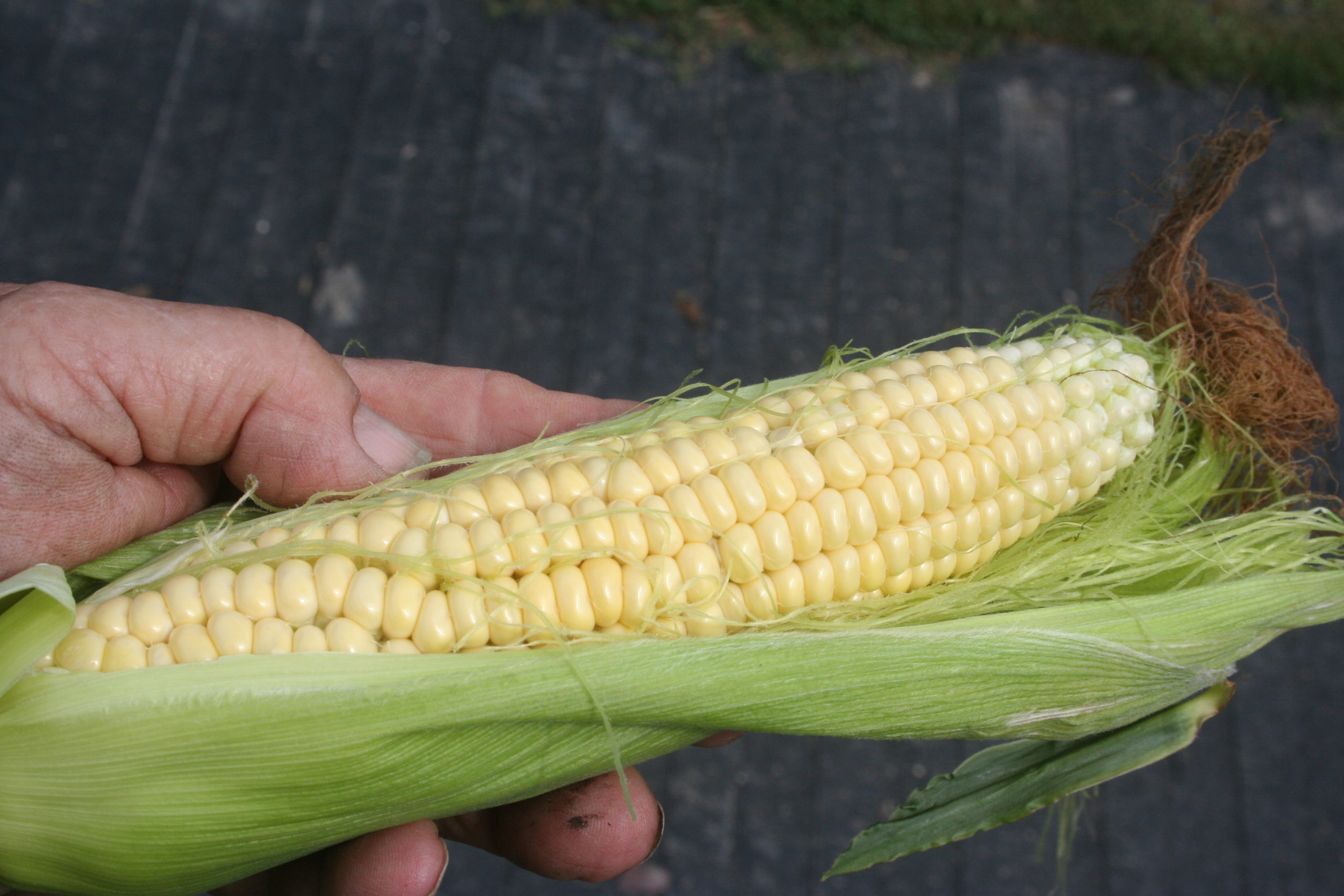
Corn should be planted in the spring, when the soil has had a chance to warm up. If planted in cool soil, the seeds will not germinate and will rot in the ground. Plant in rows about 6″ apart and rows between 24″ to 36″ apart, depending on your cultivation method. It is better to plant at least four rows in a block rather than one or two long rows because corn is wind pollinated and the block of rows gathers more pollen than does a long row. Signs of lack of pollination are unfilled sections on the cob. Sweet corn should be harvested when the kernels are colored and when you pop a kernel, a watery white juice flows out. The silks will usually be brown at this time but keep a close watch as open pollinated sweet corn moves fairly rapidly from the milk stage to dough where it is tougher and no longer good to eat.
Flour or cornmeal corns should be allowed to dry as thoroughly as possible on the stalk. Ideally, the husks will be dry and tan and rattle in the wind. But sometimes fall rains or predatory birds will make it necessary to pick the ears a bit sooner, husk the ears and lay out or hang in the protection of an indoor porch or garage to finish drying. Without husking the piled ears of corn will mold. Once the kernels are dry, you can shell the corn and store it in an airtight container for later use.
Corn is wind pollinated so different varieties of corn which shed their pollen at the same time, within up to a mile, will cross. So only grow one variety of corn each year unless they pollinate at different times. For instance, many field corns pollinate much later than do early sweet corns or many early flour corns.
Will sent three of our corns in to Dairyland Labs in Wisconsin for testing. The results were astounding, especially as run-of-the mill, GMO field corn which is ground into “store” cornmeal, etc. runs about 7% protein. Check out the results in the different corn varieties for a surprise!
CORN about 1 1/2 0z per pack
POPCORN

Amish Mushroom Popcorn
Amish Mushroom Popcorn We found this wonderful golden popcorn in an Amish community in Pennsylvania. The ears are often 8” or longer, with multiple ears on a plant. The kernels pop in a rounded shape with little hulls. 100 Days 1 Oz

Dakota Black Popcorn
Dakota Black Popcorn Here’s a great heritage corn which is not only beautiful in fall displays and decorations but it tastes nutty as popcorn or ground into cornmeal. Shining, pointed black kernels fill these five inch cobs to the tip. This is a very productive corn and I think you’ll love it. 95 days to mature 1 oz per pack as the seeds are small

Glass Gem
Glass Gem popcorn We read the raves of this gorgeous Cherokee-bred corn on the internet and in Farm Show Magazine and decided to try it. WOW. The plants are 9′-10′ tall and stool out with six or so tillers so you end up with a jungle of a plant. And most tillers produce ears too. We harvested an average of four ears per plant of 5″-6″ cobs of tiny-seeded corn. But wait! That corn comes in such a variety of colors you seldom see in “Indian” corn; pink, lavender, purple, mauve. And the kernels are glistening colors like little pearls. Very nice. And you can pop it. (No the typically white fluff of the popcorn isn’t colored in Glass Gem; just the hulls.) Or you can grind it into cornmeal if you wish. One ounce per pack (as the seeds are small) 100-110 days.

Early Pink Popcorn
Early Pink popcorn I was tickled pink when I shucked the first of this corn in our new Sand Garden! Those nice 5′ high plants were sturdy, each bearing two 5″ ears of the most gorgeous pink kernels you can imagine. And they were quite early too, which is a plus for we Northern gardeners. Not only can you grind this corn, as it was traditionally done, but it pops very nicely too. Very nutty and rich tasting fluffy white puffs. 90 days 1 oz package
FLOUR CORN TO GRIND FOR MEAL OR USE FOR DECORATION


Bear Island Chippewa ancient corn from Northern Minnesota.
Bear Island Chippewa This very old, extremely rare Ojibwa flint, flour corn from Northern Minnesota is simply wonderful! It is colored much like Painted Mountain but runs a bit more to the gold, bronzes and reds. Also, the cobs and kernels are larger. 8-10 rows of large, fat kernels. It makes very good cornmeal with a sweet flavor. Best of all, it’s early and hardy. 85 days to mature, dry corn. 11.73% protein! 1 1/2 oz per pack

Navajo Robin’s Egg Blue
Navajo Robin’s Egg Blue I first grew this corn way back when I lived in New Mexico. This traditional, ancient corn, grown by the Navajo in Arizona and parts of New Mexico was used as a soft flour corn, ground and made into corn cakes and tortillas. We love it, both to eat, and for its beauty and Native cultural and religious significance. Today, it is very rare! 110 Days

Papa’s Red
Papa’s Red First offered by Baker Creek Heirloom Seeds, and bred by Montana corn breeder, Ed Schultz, I was lured in by the beautiful, bright red flint ears on the quite early flour corn. But after growing it I found that it also produces very beautiful cornmeal and is hugely productive too. It weathered our drought with a chuckle. You should give it a try too! 85 days

Seneca Blue Bear Dance
Seneca Blue Bear Dance I have been growing this corn for nearly thirty years now and we simply love it. Seneca Blue Bear Dance Corn was named by Mohawk, Stephen McComer and has been growing this variety for thirty years. He received it from an old man who was a Seneca and who made a healing pudding from the corn flour for use in Iroquois Bear Dance Ceremonies. We love the variety of blues, purple, lavender and white colors too. 90 Days

Seneca Round Nose
Seneca Round Nose This is a wonderful, ancient Seneca flour corn which has also been traded to various other tribes in the area. This corn is also great eaten as corn on the cob when young. Our corn was nearly 10′ tall and had the most magnificent roots we’d ever seen! No tipping over in the wind for this baby!! The ears are long, having between 8 and 10 rows commonly, of large, glistening white kernels. Occasionally you’ll find an ear that looks like someone smeared red lipstick over the white kernels. 100 Days
SWEET CORN

Damaun
Damaun is one of the very first traditionally bred super-sweet corns. We trialed it this year and fell in love. The plants were nearly 9′ tall and had vigorous stalks, many of which had two 9″ ears of beautiful yellow kernelled corn. The flavor of this corn was outstanding. As this is a super-sweet corn, it must be isolated from other corns, or it may produce blah-tasting kernels. 75 Days

Fisher’s Earliest
Fisher’s Earliest was developed by Ken Fisher of Belgrade, Montana, just a few miles from where my mother grew up! This corn was developed to thrive in cooler weather conditions. Ours usually has 12 rows of nice, old-fashioned corn kernels that are both sweet and tender when harvested at its peak. (If let go too long, it, like all older varieties will get tough and lose quality.) We really love it! 65 Days
 Seneca Sunrise
Seneca Sunrise
Seneca Sunrise This is a sweet corn developed by Will after years of breeding. It is sweet, has fat 81/2″ cobs with 14-16 (or more) rows. A great early corn that will even dry down in the field here in Northern Minnesota. This dry corn not only makes great seed for next year but grinds very nicely for nutty, sweet cornmeal. As there is absolutely no corn grown within miles of us, you can be sure it has not been contaminated by GMO corn pollen blowing in the wind. Tested at 11.33% protein and a whopping 33.32% sugar! 67 days

Simonet
Simonet is a Canadian heirloom sweet corn. And it was grown in the North garden with no watering, whatsoever. Not only did it grow and produce but it did so abundantly! The plants are shorter but also develop tillers, which often also produce ears. Overall, most plants produced two main ears and an ear or two on the tillers, as well. And the ears were 6″ long and better. We are wowed by the sweet, tender, corny flavor. It’s a keeper, for sure!! 65 days

Who Gets Kissed was bred for ‘Sugary Enhanced’ sweetness, vigor, and disease resistance to rival hybrid corn, and boy does it deliver! This bi-colored variety was bred through a collaboration between Minnesotan organic farmer, Martin Diffley; U of Wisconsin corn breeder, Bill Tracy; and the Organic Seed Alliance in 2014. Bi-color kernels are tender and sweet. Ears are large and have up to 20 rows! Thanks to High Mowing Organic Seeds who brought this variety to the marketplace. 80 days


